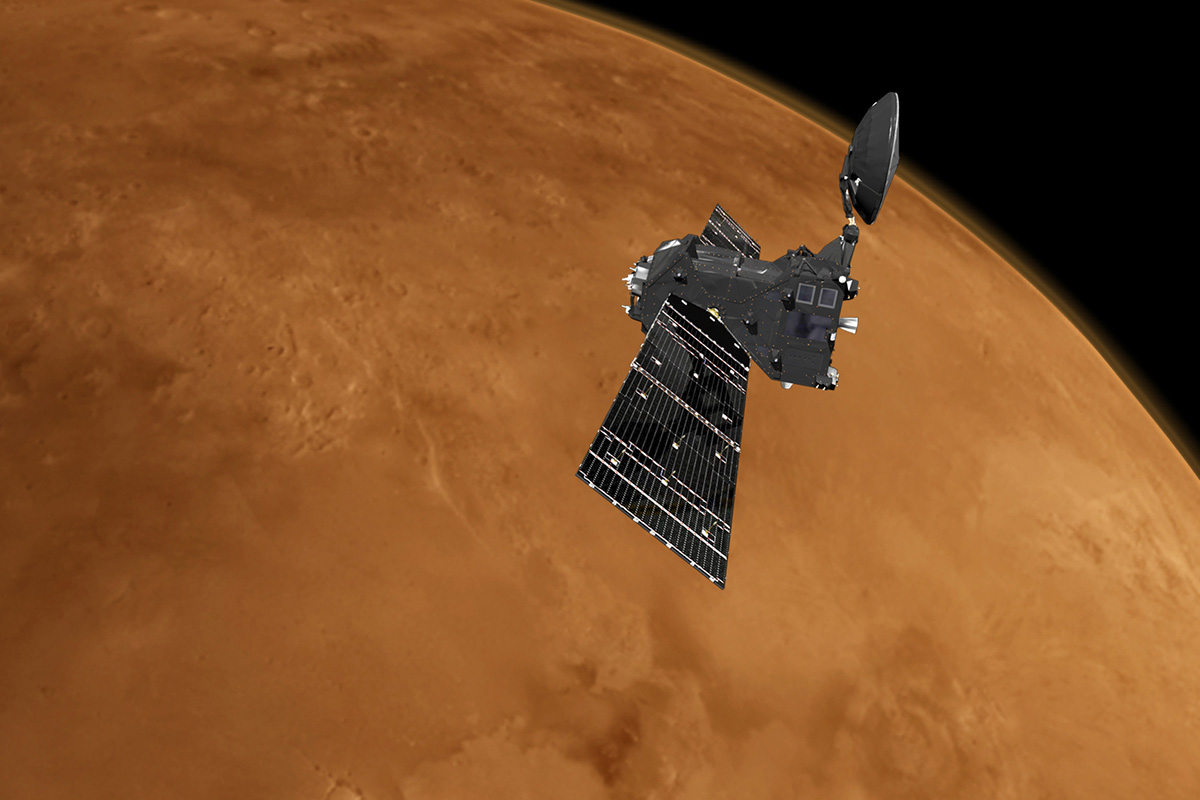Methane-Sniffing Orbiter Finishes 'Aerobraking' Dives Through Mars' Atmosphere
A spacecraft that will sniff for possible signs of life in the Martian atmosphere is nearly ready to start its science work at the Red Planet.
The Trace Gas Orbiter (TGO) — part of the European-led, Russian-assisted ExoMars exploration program — just wrapped up a nearly yearlong "aerobraking" campaign, during which it used the drag from Mars' atmosphere to lower and circularize its orbit.
"Aerobraking works only because we spent significant time in the atmosphere during each orbit, and then repeated this over 950 times," European Space Agency (ESA) flight director Michel Denis said in a statement. "Over a year, we've reduced the speed of the spacecraft by an enormous 3,600 km/h [2,240 mph], lowering its orbit by the necessary amount." [Photos: Europe's ExoMars Missions to Mars in Pictures]
When TGO arrived at Mars in October 2016, it slipped into a highly elliptical four-day-long orbit, which brought it as close to the Red Planet as 124 miles (200 kilometers) and took it as far away as 60,900 miles (98,000 km). The aerobraking campaign, which ran from March 2017 through Tuesday (Feb. 20), brought the most-distant point down to a mere 650 miles (1,050 km) while keeping the closest approach the same, ESA officials said.

There's still work to be done, however: TGO's final path is a circular one that's 250 miles (400 km) above the Martian surface. If all goes according to plan, the spacecraft will achieve this orbit by mid-April after a series of thruster firings.
TGO will begin checking out its instruments in mid-March, while these maneuvers are still going on, so the orbiter will be ready to start making science observations on April 21.
"Then, the craft will be reoriented to keep its camera pointing downwards and its spectrometers towards the sun, so as to observe the Mars atmosphere, and we can finally begin the long-awaited science phase of the mission," Håkan Svedhem, ESA's project scientist, said in the same statement.
Get the Space.com Newsletter
Breaking space news, the latest updates on rocket launches, skywatching events and more!
The science phase will involve the characterization of low-abundance gases in the Martian air, including methane, which could be a sign of life. About 90 percent of Earth's atmospheric methane is produced biologically, and astronomers have detected apparent plumes of the stuff in Mars' air several times in the past decade or so.
Methane can also be produced abiotically, however, so such plumes by themselves are not evidence of tiny Martians. Scientists hope TGO can help them figure out just where the Red Planet's methane is coming from, and what's generating it.
TGO also has several other tasks, including hunting for buried water ice and serving as a data relay for the life-hunting ExoMars rover, which is scheduled to touch down in 2021.
TGO launched toward Mars in March 2016 along with a lander called Schiaparelli, which was designed to test the touchdown technologies for the ExoMars rover. Schiaparelli crashed on the Red Planet's surface in October 2016; ESA officials later traced the mishap to a data glitch, which confused the lander's onboard computer with conflicting information.
Follow Mike Wall on Twitter @michaeldwall and Google+. Follow us @Spacedotcom, Facebook or Google+. Originally published on Space.com.
Join our Space Forums to keep talking space on the latest missions, night sky and more! And if you have a news tip, correction or comment, let us know at: community@space.com.

Michael Wall is a Senior Space Writer with Space.com and joined the team in 2010. He primarily covers exoplanets, spaceflight and military space, but has been known to dabble in the space art beat. His book about the search for alien life, "Out There," was published on Nov. 13, 2018. Before becoming a science writer, Michael worked as a herpetologist and wildlife biologist. He has a Ph.D. in evolutionary biology from the University of Sydney, Australia, a bachelor's degree from the University of Arizona, and a graduate certificate in science writing from the University of California, Santa Cruz. To find out what his latest project is, you can follow Michael on Twitter.









